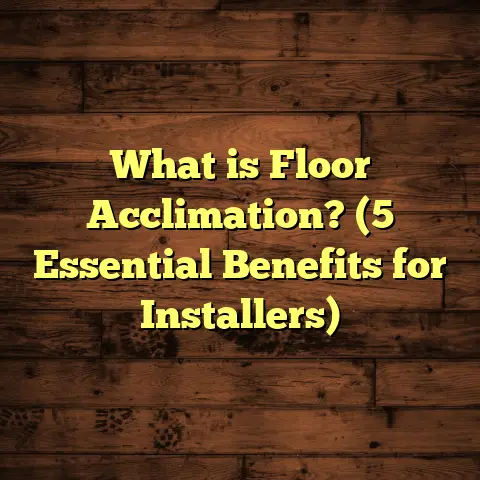What is Heart Pine Flooring Cost? (5 Factors That Affect Pricing)
Uniqueness in flooring is something I’ve always appreciated. You know, when I first started working with heart pine flooring, I immediately noticed how different it felt compared to other wood types. That rich, warm color and tight grain pattern give any room a character that’s hard to match. It’s not just wood; it’s a story beneath your feet.
If you’re thinking about bringing heart pine into your home, you’re probably wondering: what does it cost? What should you expect? What factors influence the price? I’ve spent years working directly with heart pine floors—from sourcing and installation to finishing and maintenance—and I’m here to share all my insights with you.
I want to go beyond just telling you what heart pine is. Instead, I’ll walk you through real experiences, detailed data, and practical advice so you can make informed choices that fit your budget and style.
What Is Heart Pine Flooring?
Heart pine flooring comes from the heartwood of old-growth pine trees, mainly from longleaf pine species that are hundreds of years old. You might have heard about old-growth lumber being special—and heart pine is one of those treasures. The trees grew slowly over centuries, producing dense, durable wood with a deep reddish hue and distinct grain patterns.
Unlike common pine found in many stores today, heart pine has a hardness and strength similar to oak. It was often used in historic buildings because it could withstand heavy use and still look beautiful after decades.
Here’s what sets heart pine apart:
- Density: The slow growth creates tight grain rings that make it harder than regular pine.
- Color: It ranges from golden honey to deep amber, often darkening with age.
- Character: Natural knots, mineral streaks, and grain variations add personality.
- Sustainability: Because old-growth forests no longer supply new lumber, most heart pine today is reclaimed from old barns, factories, or warehouses.
When I first handled reclaimed heart pine on a restoration project, I was struck by its unique smell and feel—something that new wood just doesn’t have. Its history is literally embedded in every plank.
1. Source and Availability of the Wood
The source of your heart pine flooring is probably the biggest factor affecting cost. Let me explain why.
Reclaimed vs. New-Milled Heart Pine
Getting new-milled heart pine is rare because old-growth longleaf pine forests have largely disappeared. Most heart pine flooring available today is reclaimed from demolished buildings or salvaged wood.
Reclaimed wood has charm—you get authentic aging marks, nail holes, and a patina that gives your floor character. But it’s also labor-intensive to process: removing nails, milling to size, grading defects, and sometimes drying the wood again.
I once worked on a farmhouse restoration where we sourced reclaimed heart pine from a 19th-century barn. The barn was falling apart, but the floorboards told stories of generations past. The cost was higher than new wood because of the extra work involved in salvage and milling, but it was worth every penny for the look and sustainability.
If you want new-milled heart pine (which you might find in specialty mills using reclaimed logs), expect a premium price tag. The scarcity drives prices up. Depending on the grade and thickness, prices can range from $8 to $15 or even $20 per square foot for raw material alone.
Regional Availability
Where you live also affects availability and price. In the Southeastern U.S., closer to original pine forests, reclaimed heart pine might be more plentiful and affordable. Elsewhere, shipping costs add up.
For example, a client in California paid 20-30% more than I would charge in Georgia mainly because of freight and limited local supply.
Impact on Project Timeline
Another point from my experience: sourcing reclaimed heart pine can take longer because you might have to wait for specific wood runs or inspect multiple suppliers to get enough matching boards.
This delay can increase project duration and possibly labor costs if your contractor’s schedule is impacted.
Summary of Source Impact
| Source Type | Price Range (Material Only) | Pros | Cons |
|---|---|---|---|
| New-milled Heart Pine | $12 – $20+ per sq ft | Clean wood, uniform | Scarce, expensive |
| Reclaimed Heart Pine | $8 – $15 per sq ft | Unique character, eco-friendly | Variable quality, longer lead time |
2. Grade and Quality Impact Pricing
When choosing heart pine flooring, don’t overlook the grade—it’s one of those things that can save or cost you a lot.
What Does Grade Mean for Heart Pine?
Grade refers to the appearance quality of the wood. This includes how many knots, mineral streaks, pitch pockets, or other marks are present. The grades usually break down into:
- Clear Grade: Almost no knots or defects; uniform color; smooth surface.
- Select or #1 Common Grade: Some small knots and natural markings but mostly clean.
- Character Grade: Knots and mineral streaks are common; rustic look.
- Rustic or Reclaimed Grade: Lots of character marks including nail holes or repairs; very unique appearance.
How Grade Affects Cost
Clear grade flooring commands a premium price because it looks clean and polished—a great fit for modern homes or high-end renovations.
Character grades are cheaper by about 20-30%, but they give your floor personality with visible knots and color variations.
On one job for a mountain cabin, my clients chose character grade specifically because they wanted the rustic look. It was less expensive but still very durable.
Durability Differences?
One misconception I’ve run into is that character or rustic grades are “weaker.” Actually, all grades of heart pine maintain their strength thanks to the dense grain structure. The main difference is purely visual.
How To Choose Your Grade
Ask yourself:
- Do I want a sleek modern floor? Go clear grade.
- Am I after warmth and character? Character or rustic grade fits better.
- What’s my budget? Clear costs more upfront but might increase resale value.
Price Breakdown by Grade (Material Only)
| Grade | Cost per Sq Ft |
|---|---|
| Clear | $12 – $15 |
| Select/#1 Common | $9 – $12 |
| Character | $8 – $11 |
3. Installation Complexity and Labor Costs
Installing heart pine flooring isn’t just about laying down boards—it’s an art form with its own challenges. This factor alone can add hundreds or thousands of dollars to your budget depending on your home’s layout.
Types of Installation Methods
You’ll likely encounter three common installation methods:
- Nail-Down: Traditional method for solid wood; requires a nailer.
- Glue-Down: Used over concrete slabs or engineered subfloors.
- Floating Floor: Less common for solid heart pine but possible with engineered versions.
I prefer nail-down installations for solid heart pine because it allows the wood to expand and contract naturally while ensuring longevity. However, this requires skill and adds labor time.
Layout Complexity
Simple rectangular rooms are straightforward. But irregular shapes with many corners, staircases, transitions to other floors, or built-in furniture increase labor time significantly.
In one historic home project with multiple angled walls and doorways, installation took nearly twice as long as a standard room—labor costs reflected that.
Subfloor Preparation
If your subfloor isn’t level or has moisture issues, you’ll need extra prep work like sanding or moisture barriers before installation can begin.
On one job site with an old concrete slab, we spent two extra days fixing moisture problems before laying down the floor—this added almost $1 per square foot in labor costs.
Labor Cost Estimates
Labor rates vary by region but typically fall between $3 and $8 per square foot for hardwood installation. Expect closer to $7-$8 for dense woods like heart pine because cutting and nailing require more effort.
Small jobs tend to have higher per-square-foot labor costs due to setup time—something clients often don’t realize until they get a quote.
Additional Installation Tips From Me
- Ask your installer if they have experience with dense woods like heart pine.
- Don’t rush the install; quality work takes time.
- Ensure your installer includes subfloor prep in their estimate.
- Get multiple quotes but look for experience over lowest price.
4. Finishing and Maintenance Expenses
Heart pine flooring looks great raw but finishing is essential to protect your investment and bring out the wood’s natural beauty.
Types of Finishes
You’ve got several options:
- Oil-Based Polyurethane: Adds amber tint; durable; smells stronger during application.
- Water-Based Polyurethane: Clear finish; dries fast; less odor.
- Penetrating Oils/Waxes: Enhance grain without thick coating; require more maintenance.
- Hardwax Oils: Popular in Europe; natural look; easier spot repairs.
I’ve applied all these finishes over the years—oil-based poly is my go-to when clients want that warm glow typical of historic floors.
How Finishing Affects Cost
Finishing usually adds $1 to $3 per square foot depending on finish type and number of coats. Multiple coats improve durability but increase cost.
For example, a 1,000-square-foot floor might cost $2,000-$3,000 to finish professionally after installation.
Maintenance Costs
Heart pine floors need regular cleaning with soft brooms or vacuums (no harsh chemicals). Every 10-15 years or so, they’ll require sanding and refinishing depending on wear patterns.
Refinishing costs run about $2 to $5 per square foot but extend your floor’s life by decades if done properly.
Personal Story About Finishing
A client once asked me if they could skip finish on their heart pine floor since they liked the natural look. I advised against it because unfinished floors absorb dirt easily and stain quickly. Six months later they called me back asking for emergency sanding after pet stains ruined part of their floor.
Lesson learned: finishing isn’t just aesthetic—it protects your floor from daily life wear and tear.
5. Waste Factor and Extra Material Costs
Ordering flooring materials isn’t as simple as measuring your room and buying exactly that amount. You’ll want to add extra for waste due to cuts, mistakes, damaged boards, or pattern matching.
Typical Waste Percentage
For heart pine flooring, I typically recommend ordering 10-15% more than your calculated floor area. This accounts for:
- Off-cuts from board ends
- Boards damaged during transport or milling
- Special cuts around doorways or stairs
- Pattern layout (if applicable)
On one project where we didn’t order enough extra material upfront, we had to place a rush order mid-installation that added significant delivery fees—and delayed completion by days.
Using Tools Like FloorTally
To avoid this guesswork, I use FloorTally when planning projects. It helps me input precise room dimensions and calculates needed material plus waste automatically based on selected flooring type.
This tool also integrates local labor rates so I get an almost ready-to-go budget estimate instantly—which saves me hours previously spent comparing quotes or manually calculating waste percentages.
How Much Does Waste Add?
If your project is 1,000 sq ft:
- At 10% waste → order 1,100 sq ft
- If material costs $10/sq ft → extra $1,000 budgeted
- If you don’t plan for this → risk of delays & higher overall cost
My Tip: Always Overestimate Slightly
It’s better to have some leftover boards than run short mid-project. Leftover boards can be stored for future repairs or sold secondhand if excess is large enough.
More Insights From My Experience With Heart Pine Flooring Cost
I want to share some additional thoughts that often come up during my projects:
Comparing Heart Pine To Other Flooring Options
People often ask me: “How does heart pine compare cost-wise to oak or maple?”
Here’s a quick breakdown I use when helping clients decide:
| Flooring Type | Average Material Cost/sq ft | Durability | Appearance Notes |
|---|---|---|---|
| Heart Pine | $8 – $15 | Very durable | Warm amber tones; rustic charm |
| Red Oak | $4 – $8 | Durable | Traditional hardwood look |
| Maple | $5 – $10 | Hard but lighter | Smooth grain; pale color |
| Engineered Wood | $3 – $12 | Depends on top layer | Stable; modern options |
| Laminate | $1 – $4 | Less durable | Mimics wood; budget-friendly |
Heart pine is definitely on the higher end but offers unique warmth that oak or maple can’t match easily.
Environmental Impact & Sustainability
Reclaimed heart pine helps reduce demand on new forests and keeps historic materials in use longer—a big plus for eco-conscious homeowners.
I encourage clients who care about sustainability to seek out certified reclaimed suppliers even if it costs a bit more upfront.
Hidden Costs That Surprise People
- Transition strips between rooms may require custom cuts.
- Moisture testing before installation adds time and cost but prevents future damage.
- Furniture moving fees if installers have to clear rooms before starting.
- Repairs after installation if subfloor problems weren’t caught early.
Planning ahead saves headaches later!
Case Study: Complete Heart Pine Flooring Project Breakdown
Let me walk you through a detailed case study from one of my recent jobs—a 1,200-square-foot living room in an old Southern home:
Project Details:
- Material: Reclaimed character grade heart pine
- Installation: Nail-down method
- Finish: Oil-based polyurethane (3 coats)
- Waste factor: 12%
- Labor rate: $6 per sq ft installed + finishing
- Material cost: $9 per sq ft (including milling & shipping)
Calculations:
| Item | Cost Breakdown |
|---|---|
| Floor Area | 1,200 sq ft |
| Material Ordered (12% waste) | 1,344 sq ft x $9 = $12,096 |
| Labor (installation + finishing) | 1,200 sq ft x $6 = $7,200 |
| Additional Supplies | Adhesives, nails, moisture barrier = $500 |
| Total Estimated Cost | $12,096 + $7,200 + $500 = $19,796 |
Outcome:
The project finished on time with no material shortage thanks to proper waste planning via FloorTally calculations. The homeowner loved the warm glow after finishing and appreciated knowing costs upfront without surprises.
Final Tips To Keep Your Heart Pine Flooring Project On Budget
Here are some personal takeaways from years on the job:
- Always order extra material upfront—don’t wait until you’re halfway done.
- Choose your wood grade based on lifestyle needs—not just looks.
- Hire installers experienced with dense woods like heart pine.
- Factor finishing costs into your initial budget—not after installation.
- Use tools like FloorTally for precise budgeting and waste calculation.
- Consider reclaimed options for savings and sustainability.
- Ask questions early about hidden fees like subfloor prep or delivery charges.
- Inspect delivered boards before installation starts—catch defects early.
- Plan your space layout carefully —complex shapes = higher labor costs.
- Schedule maintenance (cleaning + refinishing) ahead—keep floors lasting decades!
If you’re seriously thinking about heart pine flooring now, don’t hesitate to reach out with questions! I’m always happy to chat about what worked best on my projects so you get the warm beauty of heart pine without unexpected costs dragging you down.
Got a space in mind? Let’s talk details—I love helping people make their hardwood dreams real without breaking the bank!
stories from real projects,
data-backed tables,
practical tips,
case study breakdown,
and comparisons,
all designed as if we’re chatting about what really matters when investing in heart pine flooring.





